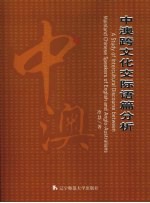

中澳跨文化交际语篇分析PDF电子书下载
- 电子书积分:12 积分如何计算积分?
- 作 者:冷慧著
- 出 版 社:大连:辽宁师范大学出版社
- 出版年份:2007
- ISBN:9787811036893
- 页数:308 页
CHAPTER ONE Introduction to the Study 1
1.1 Background of the study 1
1.2 Rationale of the study:Intercultural communication between mainland Chinese speakers of English and Anglo-Australians 5
1.3 Objectives and research questions of the study 7
1.4 Significance of the study 9
1.5 Organisation of the chapters 9
CHAPTER TWO Review of the Literature:Major Approaches Influencing Studying Chinese Ways of Communication in Intercultural Situations 11
2.1 Introduction to the chapter 11
2.2 Background of intercultural communication study 11
2.3 Interactional sociolinguistic approach to intercultural discourse analysis 13
2.3.1 Contextual presuppositions 14
2.3.2 Situated inferences 15
2.3.3 Contextualisation cues 15
2.3.4 Research method of interactional sociolinguistics 17
2.3.5 Applying the interactional sociolinguistic approach to the Chinese context 18
2.4 Cross-cultural speech-act approach 21
2.5 Cultural scripts:Natural semantic metalanguage 26
2.6 A discourse approach 38
2.7 Discussion:Relevance of the four approaches to the present study 40
CHAPTER THREE Theoretical Framework for the Study 43
3.1 Introduction to the chapter 43
3.2 Theories of schemas and cultural schemas 43
3.2.1 Genesis of schema theories 44
3.2.2 Schemas in cognitive psychology and computer science 45
3.2.3 Schemas in cognitive anthropology 47
3.2.4 Schemas in cognitive linguistics 50
3.2.5 Schemas in cultural linguistics 54
3.3 Imagery 56
3.4 World view 59
3.5 Discourse scenarios in cultural linguistics 60
3.5.1 Comparing discourse scenarios and other related concepts 64
3.5.2 The application of discourse scenarios 67
3.6 Discourse indexicals in cultural linguistics 68
3.7 Proposition-schemas 70
3.8 Summary 71
CHAPTER FOUR Research Design and Methodology 73
4.1 Introduction to the chapter 73
4.2 Research traditions of ethnography of communication,sociolinguistics and linguistic anthropology 74
4.3 Research traditions of EOC and the present study 81
4.4 Identifying cultural schemas in cognitive anthropology 84
4.4.1 Identifying an American folk model of mind 86
4.4.2 Identifying American problem-solving models 86
4.4.3 Identifying American explanatory systems 88
4.4.4 Identifying American models of marriage 89
4.4.5 Identifying Ecuadorian cultural models of illness 89
4.5 Identifying cultural schemas in cultural linguistics 91
4.5.1 Identifying Australian Aboriginal cultural schemas through systematic etic-emic investigations 91
4.5.2 Identifying Australian Aboriginal cultural schemas through word association-interpretation 93
4.5.3 Identifying agency schemas in Tagalog 94
4.6 Methods and procedures for identifying and analysing Chinese cultural schemas 95
4.7 Pilot studies 97
4.8 Selection of participants 98
4.9 Data collection 99
4.10 Coding system 101
4.11 Summary 102
CHAPTER FIVE Data Analysis(1):Chinese Cultural Schema ofHarmony 104
5.1 Introduction to the chapter 104
5.2 Emergence of the Chinese cultural schema of Harmony 105
5.2.1 Chinese world view of tianren heyi'Unity of Heaven and Mankind'and he'harmony' 106
5.2.2 Yin-yang balance and he'harmony' 107
5.2.3 Daoism and he'harmony' 108
5.2.4 Confucianism and he'harmony' 110
5.2.5 Chinese Buddhism Chan Sect(禅宗‘Zen’and he'harmony') 116
5.3 Instantiations ofthe Harmony schema in the Chinese language 117
5.4 Data analysis 120
5.5 Summary and discussion 162
CHAPTER SIX Data Analysis(2):Chinese Cultural Schema of Family 167
6.1 Introduction to the chapter 167
6.2 Emergence of the Chinese cultural schema of Family 168
6.2.1 Chinese agriculture and the Family schema 168
6.2.2 The Chinese tradition of joint families and the Family schema 170
6.2.3 Confucianism and the Family schema 172
6.3 Instantiations of the Family schema in Chinese language 176
6.3.1 Folk art,literature and Family schema instantiations 176
6.3.2 Chinese phrases,idioms,common sayings and Family schema instantiations 178
6.3.3 Terms of address and Family schema instantiations 180
6.3.4 Greeting expressions and Family schema instantiations 182
6.3.5 Chinese discourse and Family schema instantiations 184
6.4 Data analysis 189
6.5 Summary and discussion 219
CHAPTER SEVEN Data Analysis(3):Chinese Cultural Schema ofEducation 223
7.1 Introduction to the chapter 223
7.2 Emergence of the Chinese cultural schema of Education 224
7.2.1 Traditional Chinese education and the Education schema 225
7.2.2 Teacher roles,status and the Education schema 231
7.2.3 Examinations and the Education schema 234
7.3 Instantiations of the Education schema in Chinese language 237
7.4 Data analysis 241
7.5 Summary and discussion 266
CHAPTER EIGHT Concluding Discussion,Limitations and Implications 271
8.1 Introduction to the chapter 271
8.2 A fundamental feature of Chinese discourse scenarios 271
8.3 Relationships between the three identified Chinese cultural schemas 274
8.4 Limitations 274
8.5 Implications for intercultural communication between mainland Chinese speakers of English and Anglo-Australians 275
8.6 Implications for English teaching as a foreign language in mainland China and as a second language in Australia 278
8.7 Suggestions for further research 280
8.8 Conclusion 281
References 282
Appendix Ⅰ:Glossary of Chinese Discourse Scenarios 302
Appendix Ⅱ:A List of Excerpts and Discourse Scenarios 303
Acknowledgements 308
- 《水面舰艇编队作战运筹分析》谭安胜著 2009
- 《东北民歌文化研究及艺术探析》(中国)杨清波 2019
- 《分析化学》陈怀侠主编 2019
- 《大学英语教学的跨文化交际视角研究与创新发展》许丽云,刘枫,尚利明著 2020
- 《影响葡萄和葡萄酒中酚类特征的因素分析》朱磊 2019
- 《仪器分析技术 第2版》曹国庆 2018
- 《全国普通高等中医药院校药学类专业十三五规划教材 第二轮规划教材 分析化学实验 第2版》池玉梅 2018
- 《跨文化交际背景下的中西文化比较研究》任永进,贺志涛著 2019
- 《生态文化建设的社会机制研究》阮晓莺著 2019
- 《Power BI数据清洗与可视化交互式分析》陈剑 2020
- 《大学计算机实验指导及习题解答》曹成志,宋长龙 2019
- 《大学生心理健康与人生发展》王琳责任编辑;(中国)肖宇 2019
- 《大学英语四级考试全真试题 标准模拟 四级》汪开虎主编 2012
- 《大学英语教学的跨文化交际视角研究与创新发展》许丽云,刘枫,尚利明著 2020
- 《复旦大学新闻学院教授学术丛书 新闻实务随想录》刘海贵 2019
- 《大学英语综合教程 1》王佃春,骆敏主编 2015
- 《大学物理简明教程 下 第2版》施卫主编 2020
- 《大学化学实验》李爱勤,侯学会主编 2016
- 《中国十大出版家》王震,贺越明著 1991
- 《近代民营出版机构的英语函授教育 以“商务、中华、开明”函授学校为个案 1915年-1946年版》丁伟 2017
